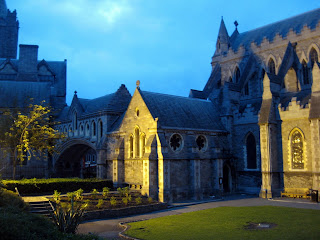Our tour guide was memorable, to say the least: a dashing gentleman and graduate in his early twenties, he was nothing if not a top-shelf toff, complete with cravat (class-conscious Aussie? No such thing!... ‘You can take the boy out of Queensland….etc.’) – and by that I mean, ‘young man brought up knowing he was going to become an MP because his parents always said so'– with an intimidating, towering intellect and the perfect annunciation of a QC from the days of olde.

Our young would-be MP or PM did, however, have a charmingly dry sense of humour, which eventually disarmed us all – e.g. “To the left you can see the former residence of one Samuel Beckett, who after emigrating to Paris famously declared that Trinity College attracts the cream of Irish society – the thick and the rich… The only difference now, of course, is that we are no longer rich…” (delivered in deep, drawn-out and deadpan tones) – and though he was aware of his charm, we didn’t hold that against him. I later learnt from Simon I wasn’t the only one suffering an inferiority complex.
However, given both the beauty of the architecture, and the undeniable rigour of its intellectual culture, I was overcome by a strange desire to attend such a college (which I realized with a pang was about as likely as me playing cricket for Australia… Incidentally, Liam spied the cricket pitch that Beckett, whom we both knew played for the college as a fast bowler, probably graced).
We were reminded by our guide along the way that the empirical philosopher Berkeley (from whom the Californian college gets its name), the revolutionary conservative politician Edmund Burke, and one of the two men to split the atom were among Trinity’s numerous illustrious alumni.

The Book of Kells – an illuminated manuscript of the gospels about fifteen hundred years old – was, while impressive, not the knockout one is led to expect. At least, I didn’t think so; I suppose it’s difficult to be impressed by ‘old’ stuff when arriving from Rome. I enjoyed the ‘Long Room’ of the library, which contained over 200,000 rare books, just as much. (Another excerpt from our dashing guide: “The Long Room is the longest college library in the world, approximately five meters longer than that at Trinity College, Cambridge – and we relish… every… centimeter”.)
By this time we all agreed it was Guinness o’clock, and embarked on a Saturday night pub crawl that would end sometime Sunday. One of our detours fortuitously lead us past Christ Church, and, eventually, the church of St. Patrick.

(Christ Church, Dublin)

(St. Patrick's)
Dusk was late, but when it finally hit the overcast sky gave way to vibrant blue, which lent the churches a more upbeat mood than that afforded by the perennial grey. Needless to say we spent the rest of the night swimming in stout and Irish whiskey, debating contemporary politics, the civil war in Palestine, London’s bonus boys and the bombing of Dresden.




























